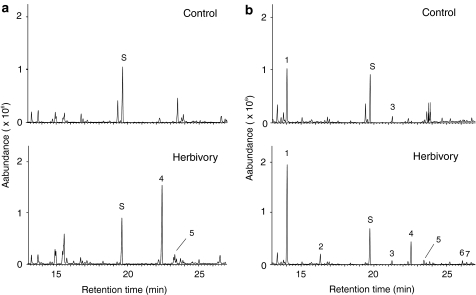Fig. 4.
Insect-induced volatile emissions from leaves of A. lyrata ssp. petraea. 20–30 P. xylostella larvae were placed on rosette leaves of individual non-flowering plants (population Neutras, Germany) and removed 24 h later. Volatiles were collected from control plants (upper panel) and insect-damaged plants (lower panel) of two selected lines, NT20 (a) and NT51 (b) as described under “Materials and methods”. GC–MS chromatograms are shown only for volatiles collected on day 2 since emission rates were highest on this day. 1 DMNT, 2 methyl salicylate, 3 (+)-cyclosativene, 4 (E)-β-caryophyllene, 5 α-humulene, 6 nerolidol, 7 TMTT, S nonyl acetate standard. Unlabeled peaks represent background volatiles or compounds whose identity could not be precisely determined by library comparison

